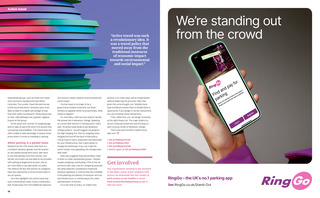


Active travel Active travel was such a revolutionary idea. It was a travel policy that moved away from the traditional measures of economic impact towards environmental and social impact. represented groups, such as those from lower socio-economic backgrounds and ethnic minorities. The London Travel Demand Survey (LTDS) found that ethnic minorities were most likely to walk on a higher percentage of trips than their white counterparts.3 Reducing access to clear, safe pathways has a greater negative impact on this group. At the same time, women of caregiving age tend to take on part-time work to fit around their care-giving responsibilities. This means they are often unable to take advantage of season ticket prices when it comes to travelling or parking. When parking is a gender issue Research by the LTDS shows that there is a correlation between gender and the location of cars parked during work hours. Men tend to use free parking more than women, and female commuters are less likely to be provided with parking arrangements at work, and so are more likely to use paid public car parks. This reflects the fact that women as caregivers have less opportunity to arrive at work early to secure spaces. All of this highlights why active travel was such a revolutionary idea. It was a travel policy that moved away from the traditional measures of economic impact towards environmental and social impact. If active travel is no longer to be a government-funded movement, but there remains an appetite within local authorities, what needs to happen? For Jess Ellery, client account lead for Jacobs, the answer lies in behaviour change. Speaking at a recent BPA Women in Parking event,4 Ellery said: All active travel projects are behaviourchange projects. I would suggest not going for the high-hanging fruit. Start by targeting lowerhanging fruit and off the back of that build a critical mass of users, supporters and advocates for your infrastructure, then it gets easier to change the landscape. If you can make the active modes more appealing, the change looks after itself. Ellery also suggests that policymakers need to listen to under-represented groups. Despite unpaid caregiving contributing 77bn to the UK economy each year, trips for caregiving purposes are rarely explicitly considered in traditional transport appraisal. It could be that this invisibility in the planning and delivery of transport services and infrastructure is contributing to the underrepresentation of women. It is a fact that no policy, no matter how positive in so many ways, will be implemented without balancing the accounts. Ellery has given this some thought, too: Mobility hubs have footfall and where there is footfall there is opportunity. If you design in human interactions, you can monetise those transactions. Then, within that, you can design inclusivity as the right thing to do. The magic bullet is to secure continual investment and find ways to start virtuous circles of behaviour change. That is the point at which market forces take over. 1 bit.ly/PNMay23CUK 2 bit.ly/PNMay23SD 3 bit.ly/PNMay23LTDS 4 Watch again at bit.ly/PNMay23WiP Get involved Any organisation wishing to get involved in the BPAs active travel initiative Park Active can download the free toolkit at park-active.co.uk/Toolkit or email Park-Active@britishparking.co.uk to find out more. 16 PN May 2023 pp14-17 Lead Feature.indd 16 25/04/2023 13:22 m209